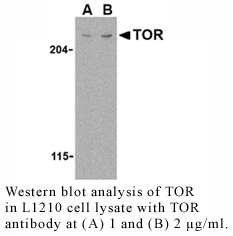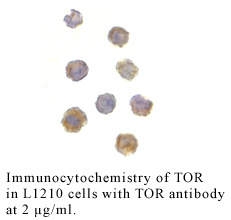Anti-Human Target of Rapamycin (TOR)
Data
- -
- -
Antibody DetailsProduct DetailsReactive Species Human Host Species Rabbit Product Concentration 0.5 mg/ml Formulation This polyclonal antibody is formulated in phosphate buffered saline (PBS) pH 7.4 containing 0.02% sodium azide as a preservative. Storage and Handling This polyclonal antibody is stable for at least one week when stored at 2-8°C. For long term storage, aliquot in working volumes without diluting and store at –20°C in a manual defrost freezer. Avoid Repeated Freeze Thaw Cycles. Country of Origin USA Shipping Next Day Ambient RRIDAB_2831878 Each investigator should determine their own optimal working dilution for specific applications. See directions on lot specific datasheets, as information may periodically change. DescriptionDescriptionSpecificity Rabbit Anti-Human Target of Rapamycin (TOR) recognizes Human and Mouse TOR. This polyclonal antibody was purified using affinity chromatography. Background The mammalian Target of Rapamycin (TOR, also known as mTOR) is an evolutionarily conserved serine/threonine kinase that regulates cell growth and cell cycle through its ability to integrate signals from nutrient levels and growth factors (reviewed in 1). It was initially discovered as a kinase whose ability to stimulate T cell proliferation in response to IL-2 could be inhibited by the immunosuppressive drug rapamycin.2,3 Rapamycin inhibits TOR in other cell types resulting in reduced cell growth and reduced rates of cell cycle and cell proliferation (reviewed in 4). TOR is normally associated with the regulatory proteins RAPTOR and GβL. Its downstream targets are thought to be the ribosomal protein S6 kinases and the eukaryotic initiation factor 4E binding proteins (4EBPs). Regulation of these protein families allows TOR to control protein biosynthesis.4 PubMed References & Citations1. Shamji, AF. et al. (2003) Mol. Cell 12:271 2. Sabatini, DM. et al. (1994) Cell 78:35 3. Cardenas, ME. et al. (1995) Curr. Opin. Nephrol. Hypertens. 4:472 4. Fingar, DC. et al.(2004) Oncogene 23:3151 Technical ProtocolsCertificate of Analysis |
Related Products
- -
- -
Prod No. | Description |
|---|---|
T281 | |
T301 |
 Products are for research use only. Not for use in diagnostic or therapeutic procedures.
Products are for research use only. Not for use in diagnostic or therapeutic procedures.




